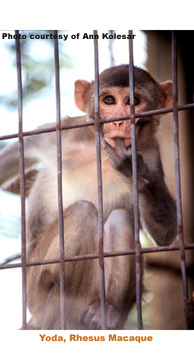| AGGRESSION |
"I may not be totally perfect, but parts of me are excellent." |
| Jen Taylor & Josh Nellist |
|
Biological Functions Twin Studies Social and Social
Factors Treatment for excessive aggression
|
Brain Functions Once a person
has inherited aggression sensitive genes or has otherwise been labeled
as an aggressive person, the next step is to study the physical
display of the biology of aggression. For this, we turn to the brain.
The modern brain is governed by the cerebral cortex, the thinking
part of the brain. Connecting the brainstem and the cortex is the
limbic system, the center that controls emotions. Stimulus to the
limbic system has produced attacking actions of specific targets
in many animals. Further, the
importance of neurotransmitters in the physiology of aggression
is undeniable. Numerous studies have been done regarding chemicals
like serotonin and hormones such as projestin and testosterone.
To begin, scientists manipulated levels of serotonin in animals,
and noticed that artificial increases in rats, mice, and monkeys
caused them to be less aggressive, whereas lower levels increased
impulsive and aggressive behaviors. Hormones play another significant role in the biological causes of aggression. The most well known is, of course, testosterone. The differences between central nervous system organization between males and females is partly based on sex hormones testosterone, which the presence of causes maleness, and estrogen, which causes femaleness, and partly on gender roles determined by culture. Because there is a higher rate of aggressive acts in males than in females, it seems logical to assume that this is caused by higher amounts of male hormones, androgens, and especially testosterone. However, while males are more prone towards aggressive behavior, this does not mean that hormones alone are the source of their aggressive drive, but rather that hormones affect the relationship between a provoking event and an aggressive response. There has been
a great deal of research done on aggression and testosterone levels
in males. One study, involving 4462 United States military veterans
showed that those men in the top 10% testosterone levels had significantly
increased aggressive and antisocial behavior, as well as multiple
sex partners and increased alcohol and drug use. It would seem then, since a great deal of aggressive tendencies are carried by the sex hormones, determined by genetics, that much of aggression is inherited. In studies of animal husbandry, cats, dogs, chickens and horses have all been bred for either high or low aggression levels. By mating two aggressive animals, a more aggressive strain is produced with in a few generations. This leads to many questions. What specific structures changed between generations? Can the results to be generalized to all species? While these studies show much evidence for inherited aggression, one must keep in mind that the same two-way relationship is true for testosterone as is for serotonin. There is evidence of changes in testosterone levels following environmental events, so that high levels of testosterone lead to higher aggressiveness, but also, aggressiveness leads to raised testosterone. While testosterone may be the best known aggression influencing hormone, it is not the only one. Another example can be seen in a study of 17 girls and 8 boys who had been exposed to Progestin, a synthetic hormone given to pregnant women at risk for miscarriage, and their 25 siblings who had not, each was assessed for aggressive disposition by asking them how they might react to a conflict situation. Results showed that both gender and Progestin exposure influenced responses.
|
 The
amygdala, a structure within the limbic system, is where researchers
believe the main seat of aggression is. In an experiment of 128
subjects with violent epileptic seizures originating in the limbic
system and causing aggressiveness and hyperactivity, intentional
destruction of parts of the limbic system, including removal of
the amygdala led to nine cases of greatly reduced violence, forty-five
of some improvement, and seventy-five with little change. Although
this evidence is not clear enough to infer significance, it does
offer a weak link between the amygdala and violence.
The
amygdala, a structure within the limbic system, is where researchers
believe the main seat of aggression is. In an experiment of 128
subjects with violent epileptic seizures originating in the limbic
system and causing aggressiveness and hyperactivity, intentional
destruction of parts of the limbic system, including removal of
the amygdala led to nine cases of greatly reduced violence, forty-five
of some improvement, and seventy-five with little change. Although
this evidence is not clear enough to infer significance, it does
offer a weak link between the amygdala and violence.  An
experiment with rhesus monkeys showed that serotonin was accountable
for 25% of their aggressive fighting behavior. The most friendly
and social monkeys had the highest serotonin levels. Further studies,
conducted by Mike McGuire and Michael Raleigh, showed that when
the dominant male in a troop of vervet monkeys was switched with
a lower male, the new dominant male had increased serotonin, whereas
the former leader became hostile and prone to random acts of violence.
A follow up study was done on fraternity brothers, which showed
that frat leaders had higher serotonin. These studies proved to
be quite important because their results show that the link between
serotonin and aggression is not one-way. Not only do low levels
of serotonin lead to bad tempers and aggressiveness, but also, bad
tempers and aggressiveness lead to low serotonin, resulting in a
dire cycle. According to Dean Hammer and Peter Copeland in their
book, Living with Our Genes, "It doesn't take much imagination
to realize that a person who is born in poverty, who lives in a
slum, who doesn't have a good education, who has the "wrong" skin
color, religion, or language, might expect to have low social status.
An
experiment with rhesus monkeys showed that serotonin was accountable
for 25% of their aggressive fighting behavior. The most friendly
and social monkeys had the highest serotonin levels. Further studies,
conducted by Mike McGuire and Michael Raleigh, showed that when
the dominant male in a troop of vervet monkeys was switched with
a lower male, the new dominant male had increased serotonin, whereas
the former leader became hostile and prone to random acts of violence.
A follow up study was done on fraternity brothers, which showed
that frat leaders had higher serotonin. These studies proved to
be quite important because their results show that the link between
serotonin and aggression is not one-way. Not only do low levels
of serotonin lead to bad tempers and aggressiveness, but also, bad
tempers and aggressiveness lead to low serotonin, resulting in a
dire cycle. According to Dean Hammer and Peter Copeland in their
book, Living with Our Genes, "It doesn't take much imagination
to realize that a person who is born in poverty, who lives in a
slum, who doesn't have a good education, who has the "wrong" skin
color, religion, or language, might expect to have low social status.
 With
that comes low serotonin, and with low serotonin comes aggressiveness,
hostility, and violence, which of course, can only lead to more
of the same."
With
that comes low serotonin, and with low serotonin comes aggressiveness,
hostility, and violence, which of course, can only lead to more
of the same."  Similar
results were found in other aggressive types, such as hockey players
and prison inmates. In fact, the same results are found in all species.
Even the spotted hyenas, whose pack is run by violent females, are
subject to testosterone's effects. In the womb, the female hyenas
are introduced to testosterone as high as their male counterparts,
and higher than any other species.
Similar
results were found in other aggressive types, such as hockey players
and prison inmates. In fact, the same results are found in all species.
Even the spotted hyenas, whose pack is run by violent females, are
subject to testosterone's effects. In the womb, the female hyenas
are introduced to testosterone as high as their male counterparts,
and higher than any other species.